It would seem New Zealand’s forestry industry has hit the doldrums. Or is it just on a holding pattern until things, hopefully, turn for the better?
The export log price index was reported on a five-year low – hardly making the $85/JasM3 mark for top A grades. Then oops! Down another $2 in the export log price index in the July report. Earlier this year A grades were fetching up to $138 at wharf gate. Pruned grades up to $190 AWG. The domestic market was holding well, but the current downturn in housing stock development has put a damper on prices at mill gate (AMG).
We are told this is mainly due to escalating bank interest rates and high inflation – the investment appears to be drying up.
On top of that the Forest Industry Contractors Association (FICA) reports some logging crews are being stood down, and corporate forest owners have eased up on harvest volumes.
Along with extreme weather events and global market hiccups, conflagrations in Ukraine and Middle East, our forest industry is being hit.
Adding to the negatives affecting forestry is the general public’s vision, with some support from mainstream media, of landscapes covered in pine trees – the ugly sight of cutover harvest sites with debris awash over farmlands, rivers and beached after extreme weather events.
Plus there’s the monotonous green take-over of indigenous landscapes by exotic conifers of uncontrolled wilding spread, although they sequester carbon.
It’s proving something of an uphill battle for the industry to raise the profile of forestry, but many forest owners are attempting to put this right.
Ernslaw One, which has taken some stick over the effects of the recent cyclones on the North Island East Coast, is now instrumental in the big clean-up.
Company CEO, Darren Mann, says although export prices have dropped considerably, “over the last three months Ernslaw has stayed true to our philosophy of valuing long term, and we have done this by keeping all our contractors working”.
This has meant easing back on production “slightly in areas of high exposure to the market, whereas in the Southern North Island operations we have continued to supply to our own mills at almost 100%”.
“In Southern Hawkes Bay we have continued to harvest at normal levels to ensure deck cargoes are available for our greater shipping programme, even though stumpages have been negative, and in Otago we have kept crews at normal levels where stumpages have been more positive than elsewhere,” he says.
Mr Mann explains that the company continues to review production levels monthly through the downturn.
“The company does not expect the situation in China to improve over the next few months. But we are hopeful that the demand for logs will pick up in response to the lowering supply and usual seasonal uptake.
“While there continues to be government stimulus in China to help reactivate the property sector by addressing liquidity gaps and lowering interest rates for first time home buyers, there isn’t a lot...





